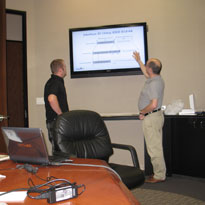RF Propagation, Fading, Link Budget Analysis
- Course:RF Propagation, Fading, Link Budget Analysis
- Course ID:RFPROP Duration:2-3 days Where: Your Office (7+ Persons)
- Download Course Description (PDF)
Available as a private, customized course for your group at your offices or ours and in some cases as a WebLive(TM) class.
Course Outline
- The Electromagnetic Spectrum
- FCC’s Wireless Telecommunications Bureau (WTB): Structure and mission
- Types of FCC licensed radio services
- Spectrum groups and typical applications for each
- HF
- VHF
- UHF/SHF
- Microwave
- Millimeter wave
- Radio Frequency (RF) Transmission, Reception, and Propagation
- Glossary of common radio propagation terms and acronyms
- Why do we need to study propagation?
- Relationship of propagation phenomenon to wireless network modeling and design
- Theory of radio frequency (RF) propagation
- Examining the basic radio wave components: (E) and (H) fields
- Sky wave vs. ground wave propagation
- Line-of-Sight (LOS) and non-Line-of-Sight (non-LOS) propagation
- Free space path loss models
- Frequency and wavelength calculations
- Basic modulation theory
- Bits per second per hertz efficiency
- Bit rate vs. symbol rate
- Digital and analog modulation: Advantages and disadvantages
- Wireless Multiple Access Methods, Applications, and Comparisons
- FDMA
- TDMA
- CDMA
- Factors Affecting the Behavior of Radio Waves: Path Attenuation
- Reflection
- Refraction
- Scattering
- Diffraction
- Earth’s curvature
- Fresnel Zones
- Radio Propagation in a Mobile Environnent
- Multipath fading
- Rician, Raleigh and Nakagami fading
- Threshold crossing rate and average fade duration
- Delay spread
- Scatter function, WSSUS model and SCRM model
- Doppler shift effects
- Coherence time and coherence bandwidth
- Dealing with channel impairments
- Forward error correction (FEC)
- Interleaving
- Channel coding theory and practice
- Voice coding: Why do we need it?
- Basics of voice coding and decoding
- Waveform coders
- Source coders (vocoders)
- Hybrid coders
- Multipath fading
- Antenna Configurations and Performance in the Context of RF Propagation Issues
- Basic antennas: Isotropic and dipole radiators
- Concept of antenna gain and gain references
- Calculating and measuring antenna gain
- Effective Radiated Power (ERP)
- Antenna patterns and pattern features
- How antennas achieve gain
- Reflector techniques, array techniques
- Families of antennas used in wireless: Architecture and characteristics
- Collinear vertical antennas
- Horizontal arrays: Yagis, log-periodics, etc.
- Implications of propagation driving antenna selection
- Multipath scattering in mobile clutter environment
- Beamwidths and tilt considerations for base station antennas
- Radiation patterns
- Gain antenna types, composition and operational principles
- Antenna gains, patterns, and selection principles
- Antenna system testing and evaluation
- Radio Propagation Models and Their Uses
- Simple analytical models
- General area models
- Point-to-point models
- Local variability models
- The Okumura model
- The Hata model
- The EURO COST-231 model
- Morphological zones
- Walfisch-Betroni/Walfisch-Ikegami models
- Propagation modeling tools
- Indoor and pico-cell prediction models
- Urban model predictions for macro, micro and pico cells
- ITU-R Propagation Models and Prediction Methods
- Terrain effects
- Propagation over smooth earth
- Propagation over smooth earth
- Propagation over irregular terrain
- Diffraction and microwave interference
- Diffraction over irregular terrain
- Diffraction in microwave interference (site shielding)
- Ground and obstacles, effects of buildings, outside
- Short-range outdoor propagation
- Link Budgets
- Understanding the link budget equation
- Line-of-sight (LOS) path loss models
- The Fresnel zone
- Path loss and free space path loss
- Antenna gain
- Frequency considerations
- Atmospheric, weather and rain attenuation
- Terrain factors
- Multipath loss
- Rician and Raleigh fading considerations
- Cochannel interference
- Transmission line loss
- A typical link budget calculation for a cellular network
- Conclusion: Recap, Q/A, and Evaluation
Course in a Nutshell
“RF is RF,” is an expression often heard from RF engineers. However, the understanding of RF propagation is far from intuitive, and the lack of this understanding can adversely affect the system performance. How does the RF energy propagate through space? How is it impacted by the presence of buildings,mountains, lakes, vegetation, and other natural and man-made structures? How does one “budget” for the gains and losses that inevitably occur on the way from the transmitter to the receiver? These are the issues at the heart of this course.
The course will give you the understanding you need to identify the right propagation model to use in a given situation and apply it correctly. It will help you understand and anticipate the effect of natural and man-made structures ranging from such fixed objects as a mountain to a highly variable one as a truck passing by on an adjacent highway. A solid grasp of these phenomena will help you appropriately “budget” for them which, in turn, will help you design or optimize a network within existing budgetary and KPI constraints.
Customize It!
Do you work with a particular technology, such as microwaves or satellites? Or are you interested in a particular aspect of propagation, such as indoor or microcell RF propagation? Are you an engineer interested in optimizing the performance of your RF system or device, or are you a sales person whose work requires some understanding of this subject? Whatever your job title or reason for taking this course, we can customize it, usually at little to no added cost, to your specific background and application.
If you are interested in an integrated treatment of antennas and RF propagation, the two courses are available as a 3-4 day combination course.
Aimed At
Those new to RF engineering as well as the experienced engineers who can use a refresher on this important subject.
Prerequisites
You should have at least a year of experience in the field of communication engineering, fixed or wireless telephony, IT, or related fields, comfort with Mathematics and Physics, and basic understanding of RF systems such as might be gained by taking either of the courses listed above.

